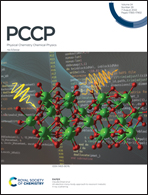Spectroscopic study of D1–A–D2–A terpolymer films for optoelectronic applications
Abstract
Several strategies have been considered in search of more efficient organic materials for charge transfer in photovoltaic devices. Among them, the integration of donor–acceptor (D–A) functional units on a conjugated copolymer has been widely applied. In this framework, we evaluated four terpolymers made up of donor moieties derived from 9,9-dioctylfluorene and 9-(heptadecan-9-yl)-9H-carbazole combined with 2,1,3-benzothiadiazole, the acceptor moiety, in different monomer ratios and polymerization routes (block and random microstructures). The preferred molecular orientation and charge transfer dynamics of the polymeric films were assessed by near edge X-ray absorption fine structure spectroscopy (NEXAFS) and resonant Auger electron spectroscopy (RAES) around the sulfur K-edge. Charge transfer times (τCT) were estimated by the Core–Hole Clock (CHC) method. Films with a high degree of organization were identified for the block terpolymer and random terpolymers with uneven amounts of donor units, showing a preferred orientation of the benzothiadiazole (BT) molecular plane parallel to the substrate surface. The values of τCT measured for all terpolymers were higher than those for typical polymers used in photovoltaic devices, which is not desirable for this type of optoelectronic application, but this may be correlated to the strong acceptor character of BT, the unit probed. To investigate the effect of film formation on the excited state behavior, steady-state and time-resolved photoluminescence measurements were also conducted. X-ray photoelectron spectroscopy (XPS) was employed to characterize the surface chemical composition of the terpolymer films. Based on the spectroscopic data the block copolymer appears to be the most suitable for the desired application.



 Please wait while we load your content...
Please wait while we load your content...